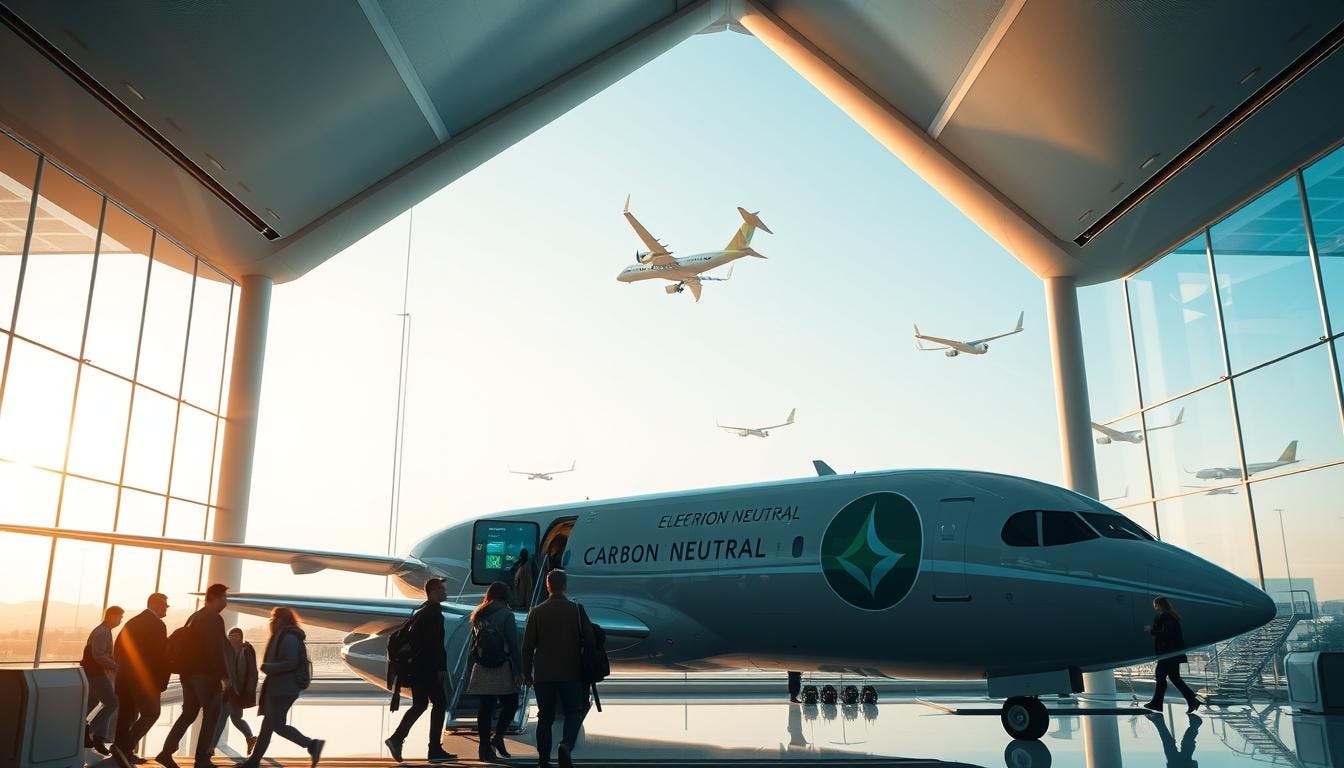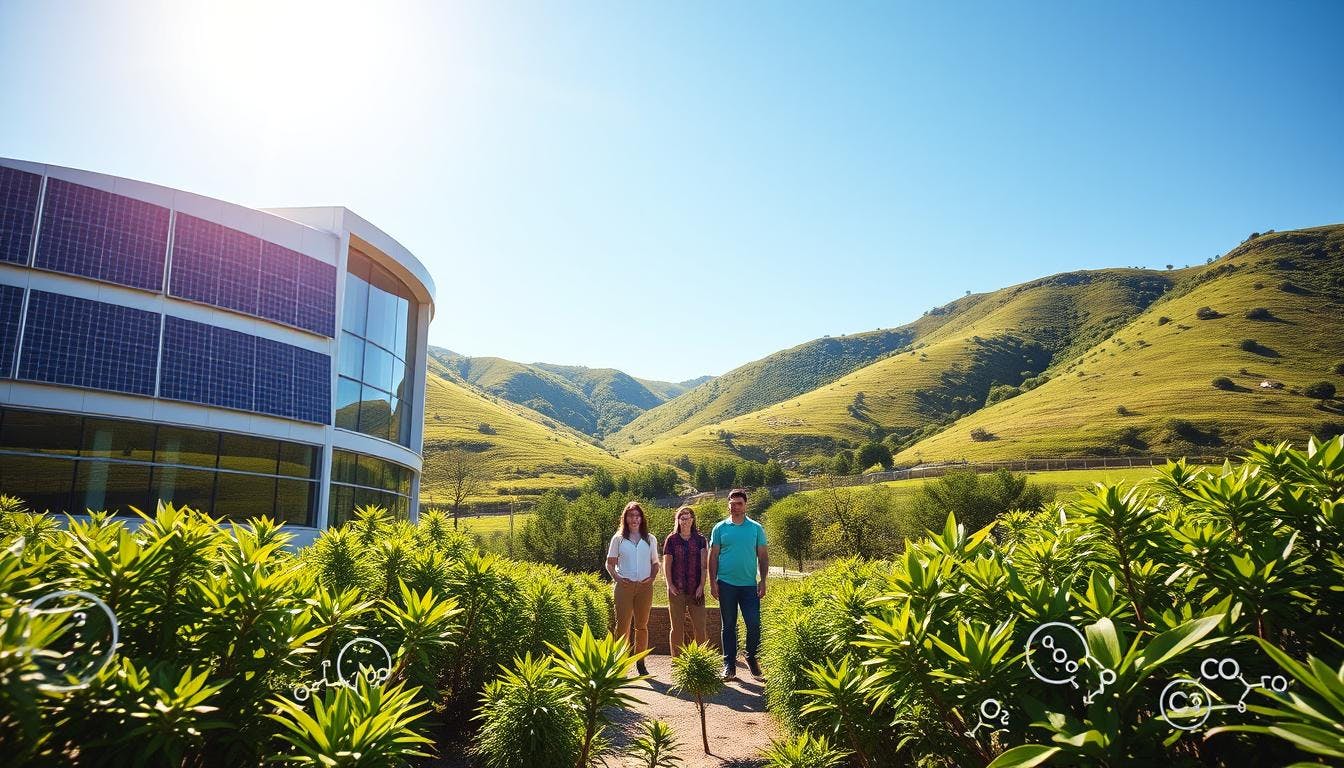Go the extra mile
Towards a cooler planet
How to book verified carbon-neutral tours through online agents
Eco-conscious travelers are looking for ways to lessen their environmental impact. The demand for sustainable travel has skyrocketed, with searches for "sustainable travel" rising by 70% in recent years. This shows a growing awareness of carbon emissions and their impact on our planet.
Verified platforms are key in ensuring transparency and accountability. Companies like Kuoda Travel, with their Climate Positive Certification, lead in nature-compatible journeys. These options let travelers enjoy their trips while supporting sustainability.
This article gives steps to find and choose verified, eco-conscious travel experiences. It stresses the importance of making informed choices for a more efficient journey.

What are carbon-neutral tours and why do they matter?
Globally, the concept of balancing travel emissions is gaining traction. Tours that offset their carbon footprint are known as carbon-neutral tours. Verified initiatives like reforestation or renewable energy are used to achieve this. General nature compatible claims are not the same as carbon-neutral travel. Carbon-neutral guarantees that emissions are completely offset, whereas sustainable seeks to minimize harm. This directly addresses how tourism affects the atmosphere.
An excellent illustration of this dedication is Kuoda Travel. They make sure their tours satisfy stringent sustainability requirements by adhering to the Glasgow Declaration standards. For genuine change to occur, this degree of accountability is essential. 8% of the world's carbon emissions come from tourism. This large number indicates that we must take action. Particularly in biodiverse regions like South America, carbon offsets are essential for mitigating this effect.
Travelers can contribute by choosing carbon-neutral options. These tours fund environmental conservation and sustainability initiatives. This guarantees a more environmentally compatible travel future.
The rise of sustainable travel: a growing trend
Traveling sustainably is transforming how we see the world. Searches for environmentally compatible options have increased by 70%, according to recent data. This illustrates a more general change in the priorities of contemporary tourists.
Multigenerational and experiential ecotourism is growing in popularity. These days, families and groups look for experiences that align with their values. This pattern demonstrates how important environmental consciousness is becoming.
Additionally, luxury tourists are adopting sustainable practices. Many now demand sustainable programs, even though they still value exclusivity. Comfort and a low environmental impact are guaranteed by this balance.
This demand is being met by airlines such as United and Delta. In order to help passengers lessen their carbon footprint, they now offer carbon-offset flights. These programs are a step in the direction of more environmentally compatible air travel.
Itineraries that are greenwashed must be avoided by travelers. Making moral decisions requires confirming sustainability claims. This guarantees that their travels actually have a beneficial influence on the environment.

How to identify verified carbon-neutral tours
Not all claims to be environmentally compatible are accurate. It is important for tourists to verify whether a tour is truly environmentally compatible. Seek third-party certifications such as Climate Positive or Gold Standard.
CO2 estimates for trips are now displayed on Google Maps. This aids in choosing more environmentally compatible options. Carbon calculators for hotels and flights are available on Google Flights and other websites.
Reputable travel agencies collaborate with local organizations or NGOs. Local residents and the environment benefit from these collaborations. Businesses such as Responsible Travel thoroughly inspect their suppliers.
Claims without actual data should be avoided. Verified by third parties, genuine sustainable initiatives display their numbers. Selecting verified tours benefits the environment.
Step-by-step guide to booking carbon-neutral tours online
Planning a nature compatible trip needs careful steps. This guide helps you travel with care for the planet.
- Calculate Trip Emissions: Use tools like MyClimate or CarbonFootprint to estimate your trip's carbon footprint. This helps find ways to reduce it.
- Filter Tours with Sustainability Badges: Look for sustainable tours on sites like Staze and Responsible Travel. Make sure they have verified certifications.
- Select Verified Offsets: When booking, choose projects like Kuoda’s Climate Positive initiatives. These offsets help balance your emissions.
- Prioritize Direct Bookings: Book directly with certified providers. This avoids middlemen and supports nature compatible practices.
- Confirm Post-Booking Reports: Reputable agents will give you emissions reports after booking. This proves your trip is carbon-neutral.
By following these steps, you can make smart choices for your trip. This way, you support the environment and have a great time

Top online tools for booking carbon-neutral travel
Today's tourists use new tools to travel in an environmentally compatible manner. These platforms simplify planning. They offer reliable data and verified efforts to lessen environmental harm.
Low-carbon travel is the focus of some companies. MyClimate offers carbon calculators. Double-offset hotel reservations and monthly reports are offered by Staze. ByWay specializes in bicycle and train travel throughout Europe.
Google Flights can be used to compare emissions. It demonstrates how your choices affect the environment. Sustainable Travel International provides a list of verified offset projects for increased transparency.
For cruise fans, Friends of the Earth provides nature-based ratings. With the help of their report cards, you can choose nature-conscious cruise lines.
These resources help travelers make environmental decisions. By using them, you can have fun on your trip and contribute to the environment.

How to book carbon-neutral flights
Air travel can harm the environment, but there are environmental choices. Airlines like Delta and Air Canada have carbon-offset programs. These help reduce flight emissions through verified projects.
When booking, compare emissions per seat class. Economy seats have a lower carbon footprint than business or first class. Nonstop flights also reduce fuel burn by avoiding multiple takeoffs and landings.
Google Flights estimates emissions per passenger for route comparisons. This tool helps choose flights with lower carbon emissions. Offsets can be bought through airline programs or third parties like MyClimate.
Prioritize airlines using sustainable aviation fuel (SAF). SAF reduces carbon emissions more than traditional jet fuel. Making informed choices supports more efficient air travel and reduces environmental impact.
Choosing sustainable accommodations
Choosing where to stay is key to reducing travel's carbon footprint. Hotels with verified sustainability programs help. These follow strict sustainable standards.
Look for LEED or Energy Star certifications when selecting a hotel. These indicate energy-efficient buildings. Avoid resorts in fragile ecosystems that use a lot of water or energy.
Prioritize lodges with waste reduction and local hiring programs. These support the environment and local communities. Booking.com’s “Travel Sustainable” filter helps find verified properties.
- Choose hotels with LEED or Energy Star certifications.
- Avoid resorts with high resource consumption in sensitive areas.
- Support lodges with waste reduction and local hiring programs.
- Use Booking.com’s “Travel Sustainable” filter for verified options.
- Verify if carbon offsets cover both operations and guest stays.
By making informed choices, travelers can support sustainability. Sustainable accommodations ensure a positive impact on the planet.
Sustainable activities and tours to Include in your itinerary
Environmentally compatible activities can improve travelers' vacations. These choices lessen their negative effects on the environment while promoting conservation and local communities.
One excellent way to support conservation is through wildlife tours. By collaborating with groups like WWF, these tours are guaranteed to promote biodiversity. For instance, suspension bridge walks on Kuoda's Amazon tours allow visitors to experience nature while causing the least amount of disturbance.
Taking cooking lessons from local chefs is a special way to learn about the culture of a place. In addition to offering genuine experiences, these activities boost local economies. Steer clear of high-impact options that could damage delicate ecosystems, such as helicopter rides over protected areas.
For urban locations, walking or bicycling tours are the best options. They enable visitors to engage with the local environment and lower carbon emissions. To make sure your decision supports sustainability objectives, find out if tour operators give a percentage of their earnings to environmental non-governmental organizations.
- Select wildlife tours contributing to conservation.
- Book cooking classes with local chefs to support community economies.
- Avoid high-impact activities like helicopter rides over protected areas.
- Opt for walking or biking tours in urban destinations.
- Verify if operators provide a portion of profits to environmental NGOs.
By choosing sustainable activities, travelers can make a positive impact while enjoying their culture trip. These decisions ensure a meaningful and sustainable journey.
How to verify the sustainability claims of travel providers
Since greenwashing has become a major problem, it is essential to carefully review respective programs. Travelers must ensure that statements are backed up by actual actions. Examining third-party checks, reports, and certifications is necessary for this.
First, find out if the supplier is a Global Sustainable Tourism Council (GSTC) member. Being a member demonstrates that they adhere to international guidelines for environmentally compatible travel. It indicates their dedication to doing things correctly and being forthright about it.
Next, review their yearly sustainability reports. To reduce environmental harm, these should have well-defined objectives and actions. Search for information about waste, energy use, and community benefits.
Verify that all emissions, including those from visitor travel, are included in carbon-neutral claims. Real programs address every aspect of their carbon footprint.
Additionally, find out if third-party organizations like EcoCert or Green Key have validated the provider's claims. These organizations provide impartial oversight of sustainability initiatives. Their endorsements lend credibility to the provider's statements.
Companies that withhold information about their offset projects should be avoided. Sincere programs are transparent about the initiatives they fund. To demonstrate that they truly have an impact, they must be open and honest.
- Check for GSTC membership to confirm sustainable practices.
- Review annual sustainability reports for measurable goals.
- Ensure certifications cover Scope 3 emissions, including guest travel.
- Cross-reference claims with third-party platforms like EcoCert.
- Avoid providers without transparent offset project details.
By following these steps, travelers can really check if a provider's sustainable claims are true. This helps ensure their choices help the environment.
The role of carbon offsets in sustainable travel
Carbon offsets are key in making travel more sustainable. They fund projects like wind farms or planting trees to offset emissions. While cutting down emissions is important, offsets help deal with what's left.
Reduction and offsetting are different, but both are needed for sustainable travel. Reduction means using environmentally compatible ways to cut down emissions. Offsetting means paying for projects that reduce emissions elsewhere. Both are important.
Not all offsets are the same. Some may not be verified, making them less effective. Look for Gold Standard-certified projects, like those supported by Kuoda. These are known for being transparent and making a real difference.
Offsets should be used only after you've cut down emissions as much as you can. Use tools like MyClimate to figure out your carbon footprint. Then, use offsets to balance what's left.
Understanding carbon offsets helps travelers make better choices. These programs help clean our atmosphere and support global goals for sustainability.

Slow travel: a low-carbon alternative
A distinctive way to see locations without endangering the environment is through slow travel. It entails utilizing less transportation and remaining longer. This reduces carbon emissions while allowing visitors to fully immerse themselves in local culture.
In slow travel, trains are essential. Compared to short flights, they emit significantly less CO2. For example, compared to flying, taking the train from Paris to Brussels reduces CO2 emissions by 90%.
Low-carbon travel plans are made by companies such as ByWay. In Europe, they emphasize bicycles and trains. Their itineraries make it simple for tourists to follow environmentally supportive routes.
Voluntourism has a greater impact when combined with slow travel. Local projects can benefit from the assistance of travelers. This enhances their trip and helps the locations they visit.
Immersion in local culture is another benefit of slow travel. Extended stays allow visitors to experience local cuisine and customs. This adds significance to their journey.
- Trains reduce emissions compared to short-haul flights.
- ByWay offers pre-planned low-carbon routes in Europe.
- Voluntourism complements slow travel for added impact.
- Cultural immersion enhances the travel experience.
How to plan a carbon-neutral luxury trip
Luxury travel can be efficient with careful planning. High-end trips can now be sustainable. Working with the right travel agent helps enjoy luxury while reducing carbon footprint.
Agents like Kuoda offer private helicopter tours with offset options. These make luxury travel environmentally compatible. Travelers can also stay in private villas with natural energy, cutting down on fossil fuels.
Choosing hybrid or sail-powered yachts is another efficient option. They emit less than traditional boats. Furthermore, asking for zero-waste meals and environmentally conscious toiletries makes the trip more efficient.
Offsetting emissions is key in luxury travel. Projects like rainforest conservation balance the trip's carbon impact. This way, travelers help the planet.
By using these sustainable practices, luxury travel can be both fun and environmentally compatible. Careful planning makes for unforgettable trips with little environmental harm.
Case studies: successful carbon-neutral travel experiences
Real examples show how carbon-neutral travel works. They show how companies and travelers can lessen their environmental impact while having great trips.
Kuoda’s Peru tours include flights to the Nazca Lines that offset carbon. This supports Amazon reforestation. Travelers see ancient wonders while helping the planet.
A family trip used Staze-certified hotels. These hotels offset emissions with natural energy. The family had a great time while being compatible.
ByWay’s bike tour across France cut emissions by 80%. It used trains and bikes. This shows sustainable travel can be fun and sustainable.
Kuoda’s Amazon lodge stay supports reforestation. Guests enjoy nature while helping conservation. This luxury stay is also good for the planet.
A cruise with Friends of the Earth’s A-rated systems lowered its impact. The ship’s tech cut waste and emissions. Choosing carbon-neutral travel has real benefits. By picking verified programs, travelers can help the planet. This method makes exploring the world sustainable.
Future trends in carbon-neutral travel
The travel industry is changing to reduce emissions. Governments and groups are pushing for more efficient journeys. Denmark plans to make domestic flights fossil-free by 2030.
By 2030, more flights will use sustainable aviation fuel (SAF). This fuel cuts emissions compared to regular jet fuel. AI tools for tracking emissions are also growing. These tools help travelers understand their carbon footprint.
The European Union might soon require carbon labels for flights and tours. This will make environmentally compatible choices more obvious. New tech like electric ferries and hydrogen trains is also emerging. These options are better for the environment.
Companies are now focusing on Scope 3 emissions. This means they're working to reduce emissions from their supply chains and operations. This approach has a bigger impact on sustainability.
- SAF adoption will reduce air travel emissions significantly.
- AI tools will provide real-time data for emissions tracking.
- Carbon labeling will become mandatory in the EU.
- Electric ferries and hydrogen trains will transform transportation.
- Corporations will prioritize Scope 3 emissions reduction.
These trends offer new ways to travel sustainably. By using these advancements, travelers can help the planet while enjoying their trips.
Moving forward with conscious travel
Start making a difference by exploring sustainable travel options. Use carbon calculators like MyClimate for your trips. These tools help you see where you can cut emissions.
Stay updated on sustainable travel news. Follow the Global Sustainable Tourism Council (GSTC) for the latest on standards. Subscribe to newsletters from trusted providers like Kuoda for luxury eco-travel tips.
Sharing what you know helps spread sustainable practices. Share this guide with others to encourage sustainable choices. When you're ready to plan, reach out to certified agents for a smooth, low-impact journey.
17 South Street
Auckland 1010
New Zealand
info@carbonclick.com- -
- X
Sign up. Be inspired. Get clicking.
Subscribe now to stay up to date with CarbonClick, carbon offsetting and climate action.
By signing up you agree to our Privacy Policy.


